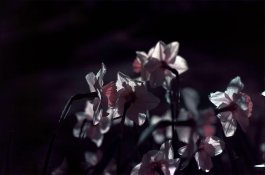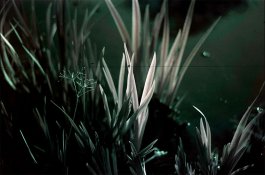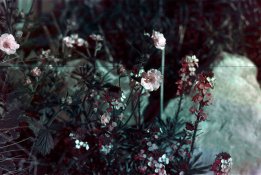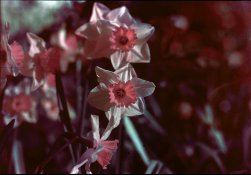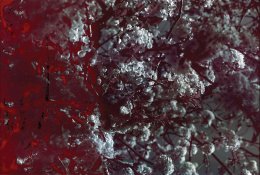AFAIK this only applies to insoluble couplers embedded in the emulsion, not to mostly water soluble ones coming with the developer.iirc some couplers require benzyl alcohol
- Home
- Forums
- Analog Workflow Forums (100% Analog/Traditional)
- Darkroom
- Color: Film, Paper, and Chemistry
You are using an out of date browser. It may not display this or other websites correctly.
You should upgrade or use an alternative browser.
You should upgrade or use an alternative browser.
Kodachrome with Rockland Polytoner colour couplers
-
A
- Thread starter alexd101
- Start date
Recent Classifieds
-
Sold Ilford HP5 Plus 400 4x5 Film
- Started by Barlow
-
For Sale 4 Toyo 4x5 Film Holders
- Started by Barlow
-
Want to Buy Mounting Flange for Compur 2 Dial Set Shutter
- Started by ivan35mm
-
Sold SOLD!
- Started by B.S.Kumar
-
For Sale FS: Sekonic L-758DR DigitalMaster light Meter
- Started by pascalkea
Forum statistics
I do see references to p-nitroacetoacetanilide. No idea if it is something one can obtain.
Artcraft sells the polytoner kit, which AFAIK contains p-Chloroacetoacetanilide, which sounds close to what you asked for.
Stephen Frizza
Member
- Joined
- Mar 2, 2007
- Messages
- 1,464
- Format
- Medium Format
I believe Steve posted his formulas on-line. They are very similar (if not the same IIRC) to the formulas given on pgs 520-521 of "The Photographic Process" by Mack and Martin 1939. These formulas work with the older Kodachromes, but will give a haze on the newer ones due to changes in the emulsions.
I used similar couplers in the example I posted last week, but completely different formulations to deal with the more modern emulsion characteristics. I am still continuing my experiments, and hopefully will have more to post in the near future.
You are correct the color and contrast is poor. Would you like samples showing results of my tests using this formula? I have never posted them because of how unsatisfactory they were. My interest in this formula was primarily in the yellow dye only. I posted his formula online at the start of april 2012 to ask Photo Engineer about the formula and its application to K-14. I was hoping to try and get an older look to my kodachrome process like earlier versions had. P.E mentioned to me in our private messages the formula was vague but it might work. it works it isn't archival and it isn't good. (sorry P.E to mention this conversation publicly)
Last edited:
kb3lms
Member
Thanks for the tip on the p-Chloroacetoacetanilide. I had forgotten about that.
What sometimes amazes me is that people can whip up batches of of all kinds of SHi%% with diesel fuel, drain cleaner, gas treatment and a little sudafed and somehow not manage to (reliably, anyway) kill themselves. How come we can't do that for a simple color coupler or some dyes?
The polytoner kit is likely the simplest and most cost-effective way to obtain couplers. Whether it can be made to work for K-chrome or not is another story entirely.
What sometimes amazes me is that people can whip up batches of of all kinds of SHi%% with diesel fuel, drain cleaner, gas treatment and a little sudafed and somehow not manage to (reliably, anyway) kill themselves. How come we can't do that for a simple color coupler or some dyes?

The polytoner kit is likely the simplest and most cost-effective way to obtain couplers. Whether it can be made to work for K-chrome or not is another story entirely.
Well, what did/do you use for the yellow dye?My interest in this formula was in the yellow dye only.
Photo Engineer
Subscriber
Steve, no problem with the mention.
You are right. The results will be crappy with anything but the right processing chemicals. Unfortunately, in order to work, color films and chemicals have to be designed together. It is a laborious process. Optimization of the dyes is also hard. I'm writing some of this up in my new book.
PE
You are right. The results will be crappy with anything but the right processing chemicals. Unfortunately, in order to work, color films and chemicals have to be designed together. It is a laborious process. Optimization of the dyes is also hard. I'm writing some of this up in my new book.
PE
Nzoomed
Member
- Joined
- Mar 30, 2012
- Messages
- 1,259
- Format
- 35mm
You are correct the color and contrast is poor. Would you like samples showing results of my tests using this formula? I have never posted them because of how unsatisfactory they were. My interest in this formula was primarily in the yellow dye only. I posted his formula online at the start of april 2012 to ask Photo Engineer about the formula and its application to K-14. I was hoping to try and get an older look to my kodachrome process like earlier versions had. P.E mentioned to me in our private messages the formula was vague but it might work. it works it isn't archival and it isn't good. (sorry P.E to mention this conversation publicly)
Was it the yellow dye that Kodak changed with the later versions of kodachrome?
I too preferred the look of the original kodachrome, there was something about Kodachrome II that i did not like much either.
These earlier versions used a different process, was it possible to process a K12 film in K14 chemistry?
I would imagine it would have been possible, but with different results?
Thanks for the tip on the p-Chloroacetoacetanilide. I had forgotten about that.
Looks like its readily available here too

http://www.sigmaaldrich.com/catalog/product/aldrich/133655?lang=en®ion=NZ
Photo Engineer
Subscriber
AFAIK, both couplers and developing agents were changed from K12 to K14. Also AFAIK, the films were not compatible either way for so many reasons it would take pages to explain.
Thinking about it, that acetanilide is not one of the best.
PE
Thinking about it, that acetanilide is not one of the best.
PE
Last edited:
DarkroomExperimente
Member
WOW....very happy to see this thread I used the Rockland Colloid couplers years ago to develop Kodachrome
got a color image....with a few flaws...I think PE told me I used too much of the couplers based on some weirdness in the image I posted
IIRC I did it back when the Polytoner was called Selectachrome
got a color image....with a few flaws...I think PE told me I used too much of the couplers based on some weirdness in the image I posted
IIRC I did it back when the Polytoner was called Selectachrome
DarkroomExperimente
Member
here are a couple images from my experiment with D-76 as the BW developer and C-41 chemicals with Rockland Colloid couplers for the rest
at the time I either forgot or didn't know about removing the remjet...most of it rinsed out with the D-76 & the rest I wiped off when doing the re-exposure steps
here's a link to a thread that has some information on what I did back in 2000: (there was a url link here which no longer exists)
Control Test: since the above produced no color, repeated RA-4 developer (20ml) and EAA (1ml): normal brownish color results.
Based on this test, it would appear that CD-3 is not a developer that will work with this coupler to form a yellow dye in film.
Jason, RA-4 developer is CD-3, so if the RA-developer forms (even brownish) dye and your self mixed developer forms none, then there is a problem with the self mixed developer, not just with CD-3.
If your self mixed developer would work, you should get at least the same brownisch result.
Have you tried this kind of developer with other dyes for magenta, for example? Just to be sure the basic developer works.
Joachim
kb3lms
Member
Or something else in the RA-4 developer is forming the stain. I did not try the other couplers. When I have a chance that sounds like a good experiment.
The only other thing to add is that in reading through Friedman's History of Color Photography, the only mention of EAA talks about a developer with no sulfite. Glafkides, in Photographic Chemistry Vol 2 (p598) says that EAA is of theoretical interest only and then goes to talk about Anilides as yellow couplers - which seems to be the path of choice. Leadley and Stegemeyer in Making Color Prints (p99) give Acetoacet-2:5-dichloroanilide as the yellow coupler.
Glafkides (Vol 2, p598) describes how to make the yellow couplers from EAA by condensing with a cyclic amine. That's a little past my knowledge of chemistry and I really don't know what it means. Perhaps others here can expand.
4'-Chloroacetoacetanilide is available. Glafkides in the same section talks about several other yellow couplers.
Evans, Hanson and Brewer, Principles of Color Photography (p259) in Figure 7.4 show EAA as a yellow coupler and in the caption it says "Couplers which, with p-aminodiethylaniline give" ... cyan, magenta and yellow dyes. IDK what "with p-aminodiethylaniline" means in this context. Again, hopefully others here might expand on this.
The same figure shows 1-naphthol and 1-phenyl-3-methyl-5-pyrazalone as cyan and magenta couplers and we know they work in the RA-4 case, which leads to the experiment you suggest, Joachim.
Diethyl Malonate is also shown in Figure 7.4 as a yellow coupler along with others. This one might be available and at least looks fairly inexpensive, about the same as 1-naphthol. No idea how it might perform.
Why EAA works with regular B/W photographic paper is a mystery to me.
The only other thing to add is that in reading through Friedman's History of Color Photography, the only mention of EAA talks about a developer with no sulfite. Glafkides, in Photographic Chemistry Vol 2 (p598) says that EAA is of theoretical interest only and then goes to talk about Anilides as yellow couplers - which seems to be the path of choice. Leadley and Stegemeyer in Making Color Prints (p99) give Acetoacet-2:5-dichloroanilide as the yellow coupler.
Glafkides (Vol 2, p598) describes how to make the yellow couplers from EAA by condensing with a cyclic amine. That's a little past my knowledge of chemistry and I really don't know what it means. Perhaps others here can expand.
4'-Chloroacetoacetanilide is available. Glafkides in the same section talks about several other yellow couplers.
Evans, Hanson and Brewer, Principles of Color Photography (p259) in Figure 7.4 show EAA as a yellow coupler and in the caption it says "Couplers which, with p-aminodiethylaniline give" ... cyan, magenta and yellow dyes. IDK what "with p-aminodiethylaniline" means in this context. Again, hopefully others here might expand on this.
The same figure shows 1-naphthol and 1-phenyl-3-methyl-5-pyrazalone as cyan and magenta couplers and we know they work in the RA-4 case, which leads to the experiment you suggest, Joachim.
Diethyl Malonate is also shown in Figure 7.4 as a yellow coupler along with others. This one might be available and at least looks fairly inexpensive, about the same as 1-naphthol. No idea how it might perform.
Why EAA works with regular B/W photographic paper is a mystery to me.
Last edited:
Photo Engineer
Subscriber
Guys, I'll say this again.....
Some color developers form leuco dyes, which are pale counterparts to the dye they are intended to form. The use of a Ferricyanide bleach is necessary in order to form the final dye. Therefore, if you use a weak bleach with a Ferric complex in it, or a blix, then the dye will not form.
PE
Some color developers form leuco dyes, which are pale counterparts to the dye they are intended to form. The use of a Ferricyanide bleach is necessary in order to form the final dye. Therefore, if you use a weak bleach with a Ferric complex in it, or a blix, then the dye will not form.
PE
kb3lms
Member
I did use Ferricyanide bleach, C22 type. And C41 flexicolor fixer.
Photo Engineer
Subscriber
Ok, then, I cannot explain it except to say that the developer or other conditions were not appropriate.
PE
PE
adycousins
Member
- Joined
- Oct 30, 2015
- Messages
- 14
- Format
- Super8
Kodachrome 40 16mm motion picture film processed using a Lomo tank, Orwo A71 as first developer and colour developers roughly based on the formulas published in the Bent /Mowrey patent but with Polytoner couplers. Ferricyanide bleach and sodium thiosulphate fix.
Heavy duty digital noise removal applied:
I’ll be returning to this once I build a new colour printing module for the red and blue re-exposures
Obviously Kodachrome is dead, for good. But the process is a very interesting challenge. Certainly makes me appreciate what a great improvement E6 is.
Heavy duty digital noise removal applied:
I’ll be returning to this once I build a new colour printing module for the red and blue re-exposures
Obviously Kodachrome is dead, for good. But the process is a very interesting challenge. Certainly makes me appreciate what a great improvement E6 is.
twelvetone12
Member
Nice results! How do you do the two exposures? Do you remove the film from the tank and pass it through some rig?
adycousins
Member
- Joined
- Oct 30, 2015
- Messages
- 14
- Format
- Super8
Sorry for the lack of response twelvetone12, I must have missed it. I remove the film from the spiral and pass it through a re-exposure device - initially I rigged something up using two Beaulieu R16 200' magazines, some Lego and LED video lights with Lee filters. I've now built an Arduino controlled device using LEDs and the glass filters specified in the K14M Theory Guide, using the exposure levels in the Guide. This week I switched to using the couplers and colour developers from the 1938 Mannes & Godowsky patent, and the first developer from the 1972 Bent & Mowrey patent. The Polytoners couplers are actually Blue, Orange and Magenta so don't produce decent colour. Here's the scan of the Super 8 Kodachrome 40 that I processed last week, using these methods:
here's the process I used:
Modified K14 process
- 05:00 remjet removal bath
- 04:00 wash
- 04:00 First development
- 02:00 wash
- 05:00 remove film from Lomo spiral
- 05:00 remove remjet - 04:00 Red exposure
- 1000 micro watt seconds per square centimetre through Kopp 2403 filter, 5mm thick
- 03:00 Reload onto Lomo spiral
- 01:00 Add Cyan coupler to developer (on magnetic stirrer)
- 12:00 cyan developer bath 20°C (constant mild agitation)
- 03:00 wash - 05:00 remove film from Lomo spiral
- 05:00 Blue exposure
- 230 micro watt seconds per cm2 through Schott BG25 glass filter, 5mm thick - 03:00 reload onto Lomo spiral
- 01:00 add yellow coupler to developer
- 10:00 yellow development bath 20°C (constant mild agitation)
- 03:00 wash
- 08:00 White light exposure
- 01:00 Add magenta coupler to developer
- 05:00 Magenta development bath 20°C (constant mild agitation)
- 03:00 wash - 08:00 Ferricyanide bleach bath 24°C - 01:00 wash
- 06:00 sodium thiosulphate fixer bath 24°C
- 06:00 wash
- 01:00 stabiliser bath 24°C
Formulas
Colour developers from Mannes and Godowsky Kodachrome patent 1938: https://patentimages.storage.googleapis.com/ed/13/21/8e8f88900704dc/US2252718.pdf
First developer from Bent and Mowrey Kodachrome patent 1972: https://patentimages.storage.googleapis.com/b6/0b/e3/fc2c18d455bfd3/US3658525.pdf
Re-exposure details from Kodachrome K14M Theory Guide: https://125px.com/docs/unsorted/kodak/tg2044_1_02mar99.pdf
here's the process I used:
Modified K14 process
- 05:00 remjet removal bath
- 04:00 wash
- 04:00 First development
- 02:00 wash
- 05:00 remove film from Lomo spiral
- 05:00 remove remjet - 04:00 Red exposure
- 1000 micro watt seconds per square centimetre through Kopp 2403 filter, 5mm thick
- 03:00 Reload onto Lomo spiral
- 01:00 Add Cyan coupler to developer (on magnetic stirrer)
- 12:00 cyan developer bath 20°C (constant mild agitation)
- 03:00 wash - 05:00 remove film from Lomo spiral
- 05:00 Blue exposure
- 230 micro watt seconds per cm2 through Schott BG25 glass filter, 5mm thick - 03:00 reload onto Lomo spiral
- 01:00 add yellow coupler to developer
- 10:00 yellow development bath 20°C (constant mild agitation)
- 03:00 wash
- 08:00 White light exposure
- 01:00 Add magenta coupler to developer
- 05:00 Magenta development bath 20°C (constant mild agitation)
- 03:00 wash - 08:00 Ferricyanide bleach bath 24°C - 01:00 wash
- 06:00 sodium thiosulphate fixer bath 24°C
- 06:00 wash
- 01:00 stabiliser bath 24°C
Formulas
Colour developers from Mannes and Godowsky Kodachrome patent 1938: https://patentimages.storage.googleapis.com/ed/13/21/8e8f88900704dc/US2252718.pdf
First developer from Bent and Mowrey Kodachrome patent 1972: https://patentimages.storage.googleapis.com/b6/0b/e3/fc2c18d455bfd3/US3658525.pdf
Re-exposure details from Kodachrome K14M Theory Guide: https://125px.com/docs/unsorted/kodak/tg2044_1_02mar99.pdf
Nzoomed
Member
- Joined
- Mar 30, 2012
- Messages
- 1,259
- Format
- 35mm
Nice to see some more experimentation into processing kodachrome, more good news is that the K-Lab that kelvin kittle rescued is being bought back to life to process the space shuttle films and they are looking at planning to roll out the service to others who own kodachrome.
Minolta93
Member
so... should I buy a couple rolls of kodachrome now in the hopes I will have someone to send it to someday?
flavio81
Member
Sorry for the lack of response twelvetone12, I must have missed it. I remove the film from the spiral and pass it through a re-exposure device - initially I rigged something up using two Beaulieu R16 200' magazines, some Lego and LED video lights with Lee filters. I've now built an Arduino controlled device using LEDs and the glass filters specified in the K14M Theory Guide, using the exposure levels in the Guide. This week I switched to using the couplers and colour developers from the 1938 Mannes & Godowsky patent, and the first developer from the 1972 Bent & Mowrey patent. The Polytoners couplers are actually Blue, Orange and Magenta so don't produce decent colour. Here's the scan of the Super 8 Kodachrome 40 that I processed last week, using these methods:
This is awesome!
My two cents: Note LEDs seldom have good color rendering. IMO you could try using good old tungsten (i.e. halogen) light sources for best color, they have a continuous spectrum.
As for the blue, orange, magenta... i wonder if there could be some kind of digital correction to "steer" the hue during the scanning phase so they get closer to the original. In other words, digitally correcting the (incorrect) hues produced by the couplers.
adycousins
Member
- Joined
- Oct 30, 2015
- Messages
- 14
- Format
- Super8
This is awesome!
My two cents: Note LEDs seldom have good color rendering. IMO you could try using good old tungsten (i.e. halogen) light sources for best color, they have a continuous spectrum.
As for the blue, orange, magenta... i wonder if there could be some kind of digital correction to "steer" the hue during the scanning phase so they get closer to the original. In other words, digitally correcting the (incorrect) hues produced by the couplers.
Thanks - I considered Halogen but that would mean also using heat absorbing glass and fans etc, the warm white LEDs don't have that smooth curve increasing over the spectrum (its quite spikey), but it seems to work well enough. The biggest issue is the decline in sensitivity of most of the films that are out there, unless I can get guaranteed fridge stored stock its unlikely that I can get realistic colour reproduction (though I'm OK with unrealistic colour repro as long as it looks interesting!). I've switched to 35mm for a while because its easier to handle 1.6 metres compared to 15 meters of Super 8.
Here's some Kodachrome 25, 35mm, expired 2000, storage unknown (am willing to bet it wasn't always kept in a fridge though!). Exposed as 20ASA. I quite like some of the results, I can see that if you don't overexpose sufficiently you have to extend first development time - which should normally be about 3:40 - 3:50 mins, in this case I extended it to 4:40 (which was still not enough), which I think basically wipes out most of the yellow, shifting the colours to the lower layers (thus causing a heavy cyan cast). I've also discovered that I need to extend the reversal bath time too, otherwise you get these strange solarisation effects (like when your E6 colour developer is exhausted). I'll be processing some more this week - K64 shot at 32ASA, again I don't know the storage history so its hit and miss.
Attachments
danny bee 5652
Member
why can't you use laser diodes for even color, or even a rgb led cell to control color second exposer? just a thought here
| Photrio.com contains affiliate links to products. We may receive a commission for purchases made through these links. To read our full affiliate disclosure statement please click Here. |
PHOTRIO PARTNERS EQUALLY FUNDING OUR COMMUNITY:  |










